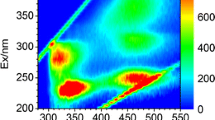Abstract
For the first time, on the basis of spectral fluorescent analysis of the surface seawater, we calculated the indices of composition and properties of the dissolved organic matter of the Kara Sea and identified the dominant fluorophors, whose fluorescence intensity quantitatively indicates the supply of terrigenous organic matter. The latter is transformed in various ways in the Ob River estuary and remote areas. The microbial biotransformation is probably the leading process of transformation of terrigenous organic matter actively delivered to the Kara Sea. The areas with an increased content of the humic components caused by formation of the desalinated lens are locally formed in the estuary zone of the Ob River.
Similar content being viewed by others
References
C. A. Stedmon, R. M. W. Amon, A. J. Rinehart, and S. A. Walker, Mar. Chem. 124, 108–118 (2011).
R. Stein and R. W. McDonald, The Organic Carbon Cycle in the Arctic Ocean (Springer, Berlin, 2004).
A. A. Vetrov and E. A. Romankevich, Carbon Cycle in the Russian Arctic Seas (Springer, Berlin, 2004).
W. S. Pegau, J. Geophys. Res.: Oceans 107, 8035 (2002).
P. G. Coble, S. A. Green, N. V. Blough, and R. B. Gagosian, Nature 348, 432–435 (1990).
P. G. Coble, C. A. Schultz, and K. Mopper, Mar. Chem. 41, 173–178 (1993).
A. Baker, Environ. Sci. Technol. 36, 1377–1382 (2002).
I. Saadi, M. Borisover, R. Armon, and Y. Laor, Chemosphere 63(3), 530–539 (2006).
R. D. Holbrook, J. H. Yen, and T. J. Grizzard, Sci. Total. Environ 361, 249–266 (2006).
S. Inamdar, N. Finger, S. Singh, M. Mitchell, D. Levia, H. Bais, D. Scott, and P. McHale, Biogeochemistry 108, 55–76 (2012).
T. Ohno, Environ. Sci. Technol. 36, 742–746 (2002).
R. M. Cory and D. M. McKnight, Environ. Sci. Technol. 39, 8142–8149 (2005).
A. J. Lawaetz and C. A. Stedmon, Appl. Spectrosc. 63(8), 936–940 (2009).
A. G. Zatsepin, P. O. Zavialov, V. V. Kremenetskiy, S. G. Poyarkov, and D. M. Soloviev, Oceanology 50(5), 657–667 (2010).
Author information
Authors and Affiliations
Corresponding author
Additional information
Original Russian Text © A.S. Ulyantsev, V.V. Ocherednik, E.A. Romankevich, 2015, published in Doklady Akademii Nauk, 2015, Vol. 460, No. 1, pp. 93–97.
Rights and permissions
About this article
Cite this article
Ulyantsev, A.S., Ocherednik, V.V. & Romankevich, E.A. Application of excitation-emission fluorescent matrix spectroscopy in analysis of marine organic matter. Dokl. Earth Sc. 460, 58–62 (2015). https://doi.org/10.1134/S1028334X15010080
Received:
Published:
Issue Date:
DOI: https://doi.org/10.1134/S1028334X15010080




